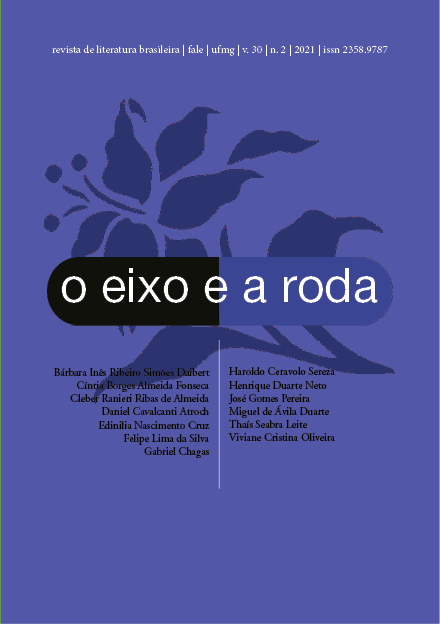Shakespeare’s Influence in Grande sertão
veredas – The Three Women and the Three Metals
DOI:
https://doi.org/10.17851/2358-9787.30.2.100-120Keywords:
comparative literature, Grande sertão, veredas, João Guimarães Rosa, King Lear, William ShakespeareAbstract
This article discusses how it is updated, in Grande sertão: veredas, a fundamental theme for the tragedy King Lear: the love choice involving three women related to gold, silver and lead. The symbology related to the metals is decisive for the characterization of the female characters of both the novel and the tragedy, analyzed here, in a comparative perspective. In King Lear, the precious metals, gold and silver, are associated with Goneril and Reagan, the evil daughters who inherit the kingdom, while Cordelia, Lear’s kind and preferred daughter, is represented by lead and ends up disinherited. In Grande sertão: veredas, gold and silver emerge in the characterization of Nhorinhá, the prostitute with whom Riobaldo falls in love, and Otacília, his wife, while Diadorim, the true love, is related to lead, and remains sublimated. Thus, the precious metals, in both works, symbolize the loving mistake, while the lead keeps the right woman – Cordelia, in the tragedy, and Diadorim in the novel. Diadorim and Cordélia also have other analogies: both are daughters of great leaders, dedicate unrestricted fidelity to their father, have a connection with the warrior-maiden archetype, and their deaths represent moments of anagnorisis for Riobaldo and Lear.
Downloads
References
BLOOM, H. Abaixo as verdades sagradas. Trad. Alípio Correa de Franca Neto e Heitor Ferreira da Costa. São Paulo: Companhia das Letras, 2012.
BLOOM, H. O cânone ocidental. Trad. Marcos Santarrita. Rio de Janeiro: Objetiva, 2010.
CHEVALIER, J.; GHEERBRANT, A. Dicionário de símbolos: mitos, sonhos, costumes, gestos, formas, figuras, cores, números. 24. ed. Trad. Vera da Costa e Silva et al. Rio de Janeiro: José Olympio, 2009.
DURÃES, F. S. O mito de Fausto em Grande sertão: veredas. Rio de Janeiro: Academia Brasileira de Letras, 1999.
FREUD, S. O tema da escolha do cofrinho. In: _____. Observações psicanalíticas sobre um caso de paranoia relatado em autobiografia (“O caso Schreber”): artigos sobre técnica e outros textos (1911-1913). Trad. e notas Paulo César de Souza. São Paulo: Companhia das letras, 2010. p. 301-316. (Obras completas v. 10).
GALVÃO, W. N. A donzela-guerreira: um estudo de gênero. São Paulo: Editora SENAC, 1998.
JUNG, C. G. Psicologia e Alquimia. 4. ed. Trad. Dora Mariana R. Ferreira da Silva. Petrópolis: Editora Vozes, 2009. (Obras Completas de C. G. Jung, v. 12).
MELETÍNSKI, E. M. Os arquétipos literários. Trad. Aurora Fornoni Bernardini, Homero Freitas de Andrade e Arlete Cavaliere. São Paulo: Ateliê Editorial, 2002.
MENESES, A. B. de. Cores de Rosa: ensaios sobre Guimarães Rosa. São Paulo: Ateliê Editorial, 2010.
NUNES, B. A Rosa o que é de Rosa: literatura e filosofia em Guimarães Rosa. Org. Victor Sales Pinheiro. Rio de Janeiro: DIFEL, 2013.
PASSOS, C. R. P. Guimarães Rosa: do feminino e suas estórias. São Paulo: Hucitec: FAPESP, 2000.
ROSA, J. G. Grande sertão: veredas. Rio de Janeiro: Editora Nova Fronteira, 2001.
ROSENFIELD, K. H. Desenveredando Rosa: a obra de Guimarães Rosa e outros ensaios rosianos. Rio de Janeiro: Topbooks, 2006.
SHAKESPEARE, W. King Lear. In: _____. The complete illustrated works of William Shakespeare. London: Bounty Books, 2013. p. 832-862.
SHAKESPEARE, W. O rei Lear. Trad. Millôr Fernandes. Porto Alegre: L&PM, 2015.
SHAKESPEARE, W. Rei Lear. In: _____. Hamlet, Rei Lear, Macbeth. Trad. Bárbara Heliodora. São Paulo: Abril, 2010. p. 241-429. (Coleção Clássicos Abril, v. 10).




 Esta obra está licenciada com uma Licença
Esta obra está licenciada com uma Licença 